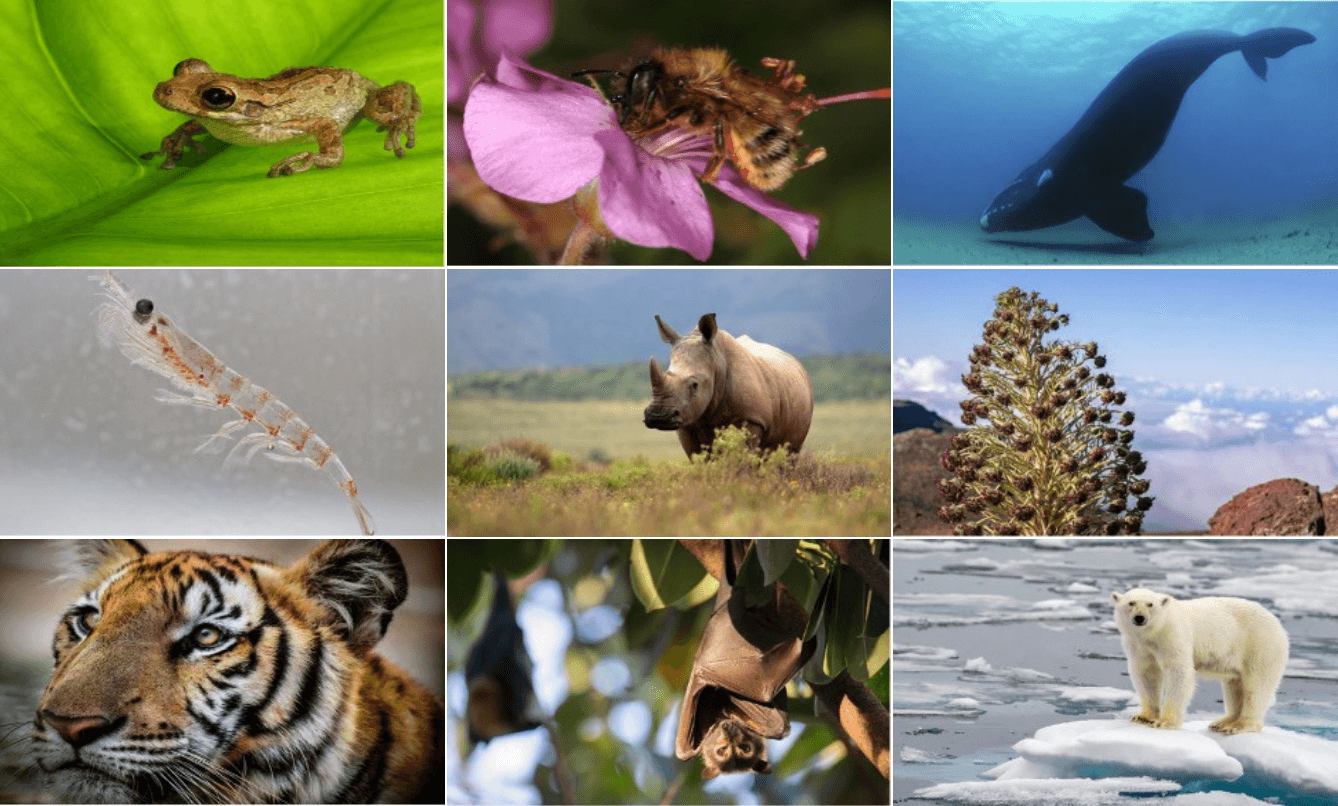Keystone species are dying out at an accelerating rate as the result of human activity. Can investments slow the destruction?
- Human activities are causing a climate crisis, which is increasingly responsible for pushing various species of animals and plants closer to the edge of global extinction. These include “keystone species” that have disproportionately large impacts on their natural
- To understand the complexities, we conducted extensive readings of scientific journals and spoke with a wide range of experts, including apiarists (bees), botanists (plant science), herpetologists (amphibians and reptiles), and ornithologists (birds).
- Modern extinction has been occurring at an accelerating rate. It’s estimated that, compared to pre-human levels, modern extinction rates for all species have been 100 to 1,000 times greater. We highlight ten keystone species, two of which are plants, that are being pushed closer to the edge of global extinction by climate
- Some investment management firms understand the need to focus on conservation and animal welfare, which, in turn, will contribute to the preservation of various keystone species. We highlight targeted thematic funds as well as ways to promote animal welfare indirectly through a focus on aligning investments to the UN Sustainable Development Goals.
For her New Yorker article1 that sparked the Pulitzer Prize-winning book “The Sixth Extinction: An Unnatural History,” Elizabeth Kolbert interviewed a number of experts on mass extinction:
I asked [a paleontologist at Harvard] to compare the current situation with past extinction events. He told me that he didn’t want to exaggerate recent losses, or to suggest that an extinction on the order of the end-Cretaceous [65 million years ago when dinosaurs disappeared] …was imminent. At the same time, he noted, when the asteroid hit the Yucatán [in the Gulf of Mexico] “it was one terrible afternoon.” He went on, “But it was a short-term event, and then things started getting better. Today, it’s not like you have a stress and the stress is relieved and recovery starts. It gets bad and then it keeps being bad, because the stress doesn’t go away. Because the stress is us.”
Three of the five mass extinctions that have occurred over the course of the past few hundred million years have been associated with climate change. In the end Ordovician period, about 450 million years ago (Mya), fluctuations in sea levels and global warming likely contributed to the extinction of 80% of marine species. In the late Devonian period, about 365 Mya, global cooling is thought to have played a role in mass extinction. The end Permian extinction, about 250 Mya, is believed to have been caused by global warming.
Today we are in the midst of the sixth mass extinction — the Holocene Extinction. As we discuss below, scientists have blamed human activity for most of the biodiversity loss in the modern era.
Climate Change and Keystone Species
While climate change has not been the predominant factor behind mass extinctions to date, it is increasingly responsible for pushing various species of animals and plants close to the edge of global extinction. These include “keystone species,” which have disproportionately large impacts on their natural environment. For example, when wolves in Yellowstone National Park were culled, the deer population exploded, which in turn meant that plant populations declined. Bears, who rely on many of the same berries on which the deer feed, also suffered from lack of food. When the wolves were reintroduced to Yellowstone, the entire community shifted back into balance.
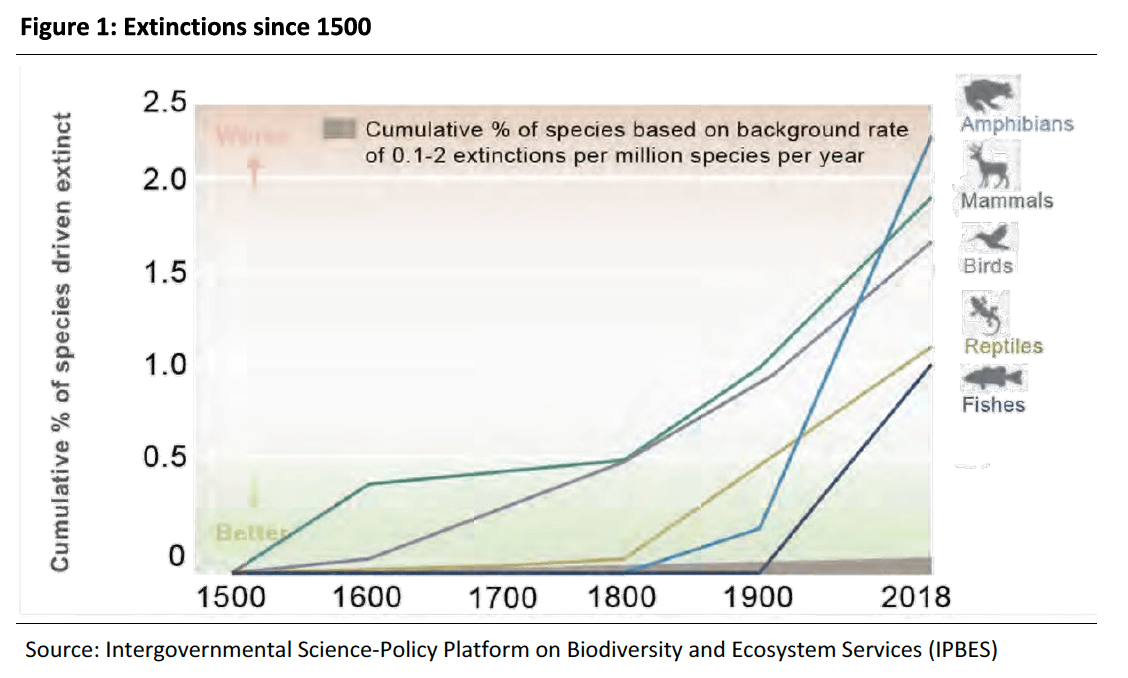
Accelerating Rate of Extinction
Modern extinction has been occurring at an accelerating rate. Several hundred well-documented species, mostly mammals, have become extinct in the U.S., including, in recent times, the passenger pigeon (1914), the Texas wolf (1942), and the Eastern cougar (2011), all of which were hunted to extinction. It’s estimated that, compared to pre-human levels, modern extinction rates for all species have been 100 to 1,000 times greater. At least 680 vertebrate species have been driven to extinction since the 16th century — Figure 1.
Five Devastating Mass Extinctions
Mass extinctions are characterized by the loss of at least 75% of species within a geologically short period of time. Over the past half-billion years, there have been at least 20 mass extinctions, when the diversity of life on earth shrank dramatically. Five of these were particularly devastating:
- During the end Ordovician period, about 450 million years ago (Mya), life was still confined mainly to water, as terrestrial vertebrates had not yet Geological records indicate that more than 80% of marine species died out. It’s believed that contributing factors were great fluctuations in sea levels, which resulted from the spread of glaciers, followed by a period of great global warming.
- The next great extinction was in the late Devonian period, about 365 Mya, when 57% of marine genera (A genera is a biological classification above a species level e.g., buteo is a genus of raptors including hawks and buzzards.) Global cooling after meteorite impacts may have been responsible.
- The end Permian extinction, about 250 Mya, was by far the worst of the five mass extinctions. 95% of all species — marine as well as terrestrial — became Called by scientists “the great dying”, this was by far the worst extinction event for which we have evidence, and nearly ended life on Earth. Many researchers believe the trigger was a sudden burst of volcanic activity, which released enormous quantities of carbon dioxide that presumably led, then as now, to global warming.
- The end Triassic extinction, about 200 Mya, is the most enigmatic, with no clear cause. Marine organisms were the most strongly affected: 53% of marine genera became extinct.
- The end Cretaceous extinction was the most recent mass extinction, about 65 Mya, resulting in the elimination of 75% of all species on earth. Most notable was the disappearance of non-avian dinosaurs. A leading candidate for the mass extinction was a giant asteroid impact in the Gulf of Mexico.
The Ongoing Holocene Extinction
The Holocene Extinction began about 11,000 years ago at the end of the last Ice Age. As in previous mass extinctions, climate is thought to have played an important part in the early stages, but humans also had a significant role.
- About 11,000 years ago the first humans are believed to have entered the North American continent. Subsequently, three-quarters of North America’s largest animals — mastodons, mammoths, giant beavers, short-faced bears, and sabre-toothed tigers — became extinct.
- The first humans settled in South America as well. Eventually, more than 30 species of South American megafauna — including elephant-size ground sloths and rhino-like creatures known as toxodons — died out.
The reasons for these early human-related mass extinctions are still being debated, with overhunting being one possibility. To be sure, human activity by itself was likely not entirely to blame. Extinction — or near-extinction — of species frequently occurs when any large, adaptable predator (i.e., invasive species) moves into a new ecosystem. By way of example:
- Following the encroachment of non-native Burmese pythons into Florida’s Everglades National Park, the populations of raccoons dropped 99%, opossums 99%, and bobcats 87%.
- The invasive brown tree snake has decimated native bird populations on the island of Guam.
Today, in addition to anthropogenic climate change — that causes, among other things, melting sea ice, which threatens polar bears — humans are contributing to mass extinction because of the way we are altering the planet. Farming, logging, and building have transformed between a third and a half of the world’s land surface. Many species have had a difficult time relocating to new, suitable habitats. Their ability to migrate is hampered by artificial barriers such as roadways, cityscapes, and suburban sprawl.
Furthermore, through global trade and international travel, humans have transported numerous invasive species that have devastated ecosystems that never developed defenses – from mice devouring albatross chicks in their nests to snakehead fish decimating native fish species across the U.S.
Two organizations, the Intergovernmental Science-Policy Platform on Biodiversity and Ecosystem Services (IPBES), and the World Wildlife Fund (WWF), ranked the largest global drivers of biodiversity loss by impact.
According to IPBES, over the past 50 years the key factors have been:
- Changes in land and sea use, g., terrestrial habitat loss, marine over-fishing.
- Direct exploitation of organisms, g., over-fishing of river networks.
- Climate change: “Global warming” that causes, among other things, fires, floods, and droughts.
- Pollution: Marine plastic pollution, in particular, has increased tenfold since 1980.
- Invasion of alien species: Cumulative records of alien species — both terrestrial and marine — have increased by 40% since 1980, driven, in part, by global trade that facilitates the transfer of species from one region to another.
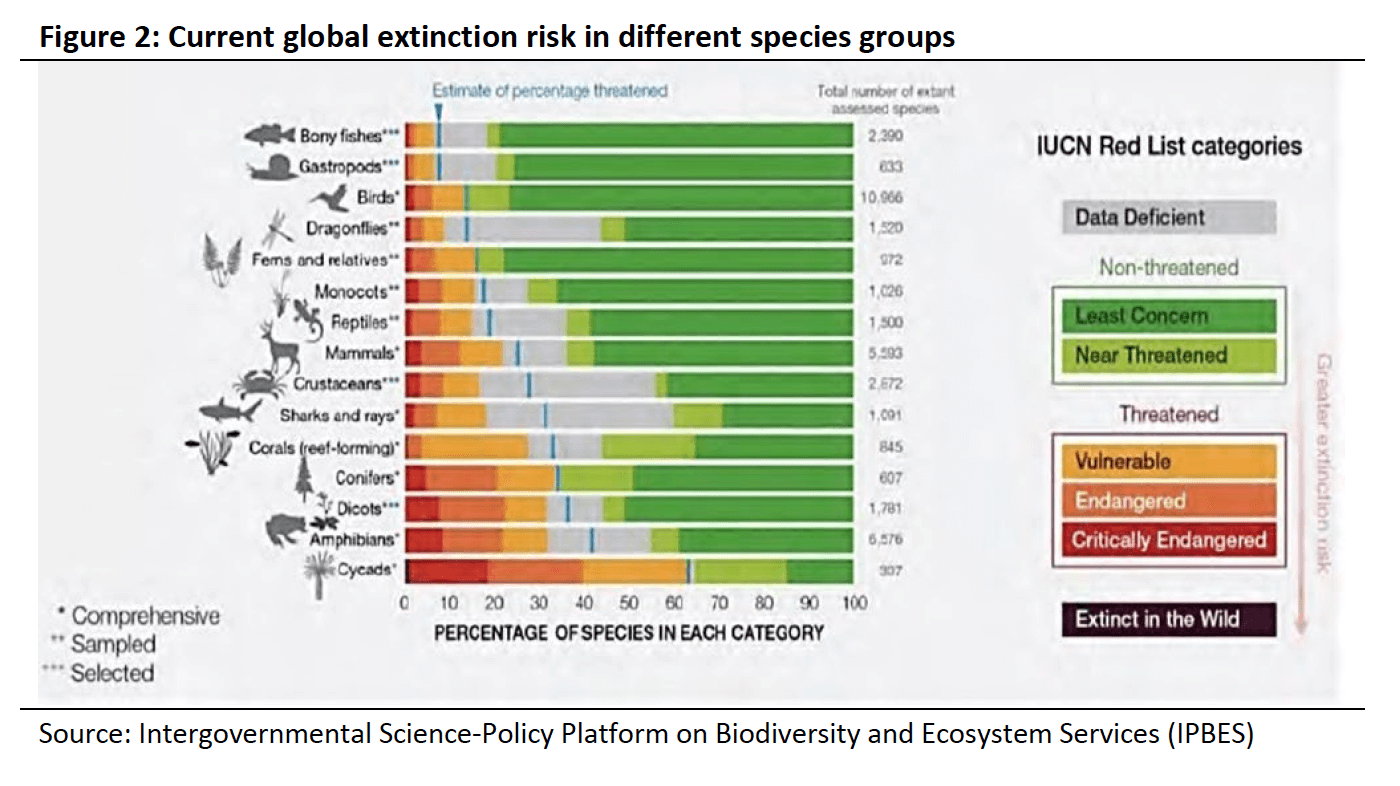
Similarly, the WWF lists the drivers of species loss and biodiversity crisis as:
- Overexploitation: Hunting, harvesting, fishing
- Agricultural expansion
- Land conversion
- Climate change
The IPBES estimated that more than one million species are currently at risk of extinction, many of which are predicted to be extinct within just a few decades — Figure 2.
The Climate Crisis and the Sixth Mass Extinction
The growing climate crisis is predicted to be an increasing contributor to species extinctions in the next 100 years. Climate can impact species in a number of ways:
- “Global warming” disturbs animals’ habitats because of fires, floods, droughts, melting ice caps and rising sea levels.
- High temperatures can overwhelm the physiologies of some species.
- And, in a knock-on effect, climate change can threaten keystone We gave the example of polar bears, a keystone species in the Arctic ecosystem that is currently threatened by ice loss.
Linking current species extinction to climate change is challenging. According to the International Union for Conservation of Nature (IUCN)2, only 20 of 864 recent global species extinctions are considered to potentially be the result of climate change: seven frogs, four snails, two freshwater fishes, six birds, and one island rodent species. Similarly, a rigorous study3 of local extinctions found 136 case studies of climatic impacts that were potentially relevant to species extinction but identified only seven instances that clearly linked climate change to extinction — Figure 3.
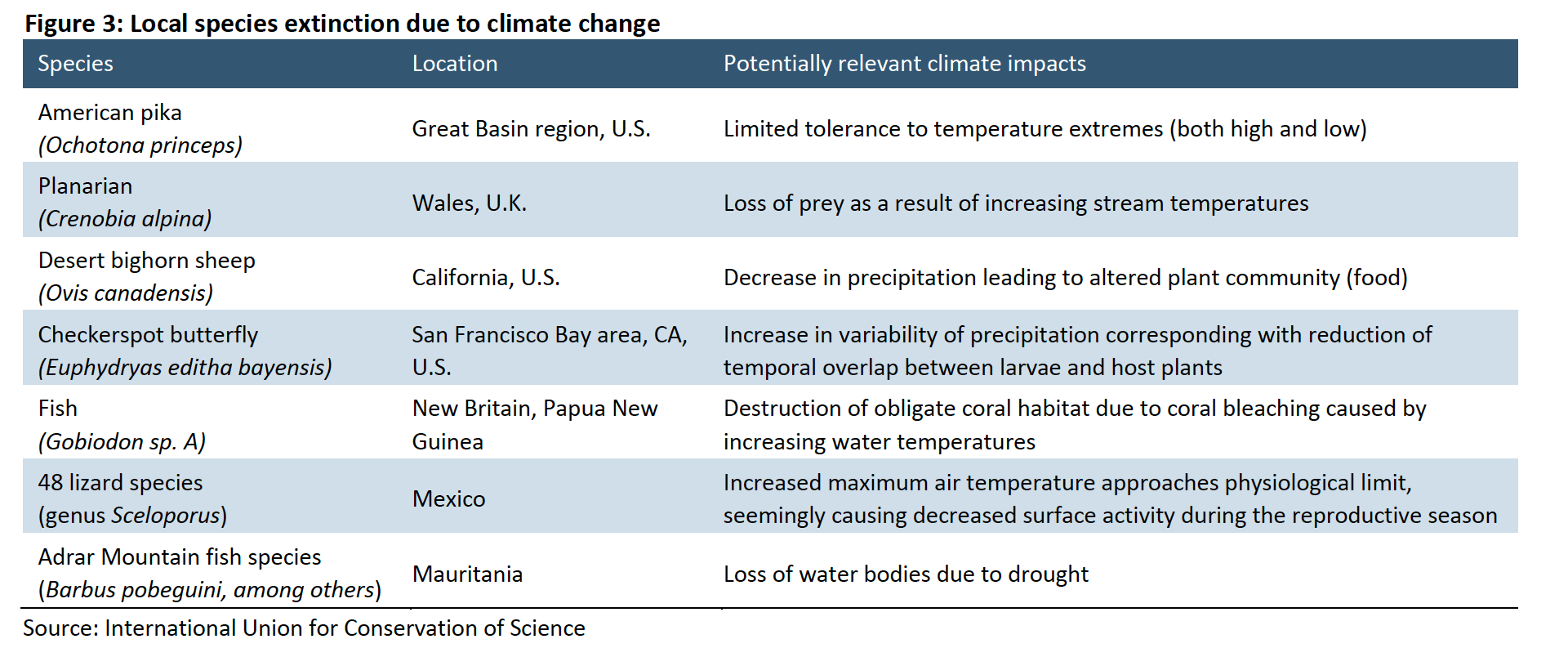
So, while climate change has not yet been a major factor behind mass extinctions, it is increasingly responsible for pushing various species closer to the edge of extinction. Figure 2 above shows the current global extinction risk of different species groups; Figure 4 below sorts by those most at risk:

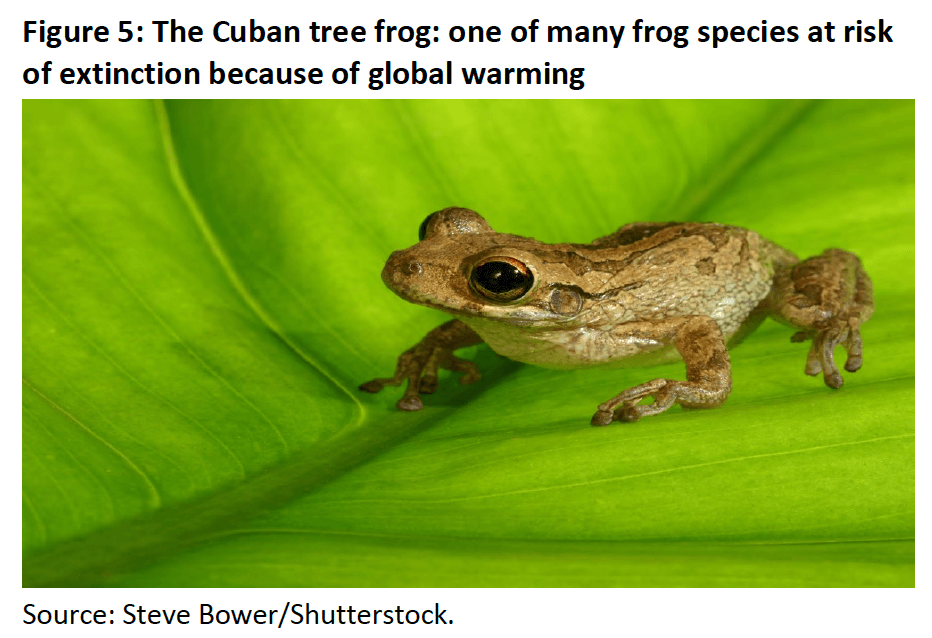
Amphibians at Risk
Frogs are a keystone species. Not only are they an important indicator of an ecosystem’s health, they help keep ecosystems in balance by eating a variety of insects and small animals.
The fungal disease chytridiomycosis, which is caused by the parasitic fungus Batrachochytrium dendrobatidis (Bd), is lethal to certain amphibians. It affects frogs and salamanders and has caused a number of species extinctions. Significantly, scientists discovered that when temperatures vary unpredictably — a consequence of global warming — frogs succumb faster to chytridiomycosis.4 The Cuban tree frog is one of many frog species threatened with extinction (Fig. 5).
Flowering Plants at Risk
Plants can also be keystone species. The disappearance of a plant species may result in the loss of animals that depend on it, such as pollinators (e.g., bees) and seed dispersers (e.g., birds).

Haleakalā silversword
Every year up to two million people visit Haleakalā National Park on the Hawaiian island of Maui, the only habitat for the endangered Haleakalā silversword — Fig. 6. The plant grows up to 1.8 meters tall and only flowers at the end of its life cycle, which can occur anywhere between 20 and 90 years after it first takes root in the rocky ground around Haleakalā volcano. Research has shown5 these silverswords have suffered a dramatic population decline in the past 20 years due to increased air temperature and reduced rainfall in their habitat, both likely caused by climate change.
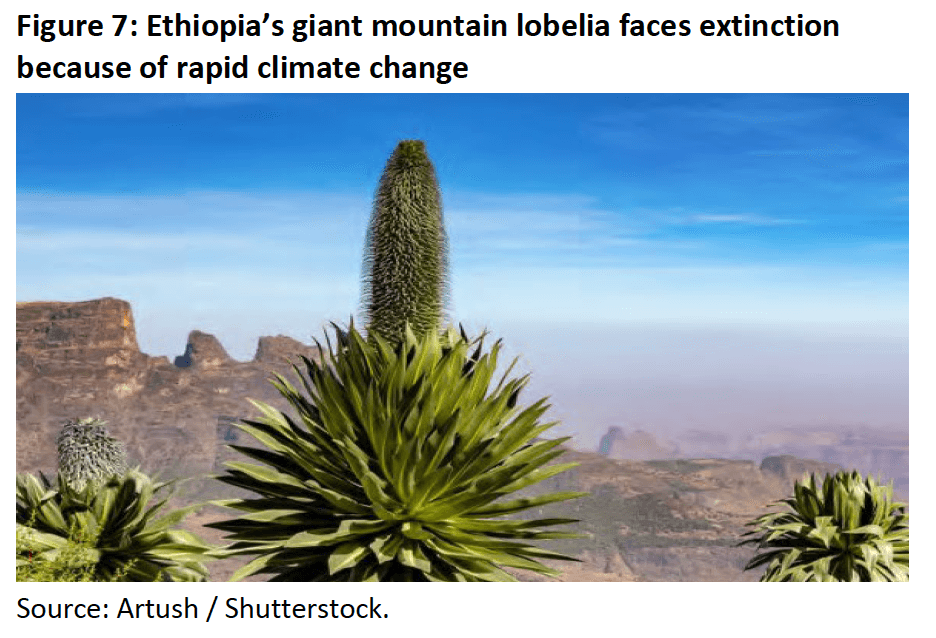
Giant Mountain Lobelia
The giant mountain lobelia, native to Ethiopia, is a spectacular- looking tropical alpine plant that resembles a spiky tropical palm but then shoots up sometimes more than 10 meters tall— Figure 7. It is not finding it so easy to adapt to rapid climate change. A scientific study6 of the plant’s prospects concluded it “will suffer massive reduction in range” under warmer climes, with just 3.4% of its habitat still suitable by 2080. By then, it is predicted to be confined to just four suitable mountain-top habitats “which may be too small to sustain viable populations.”
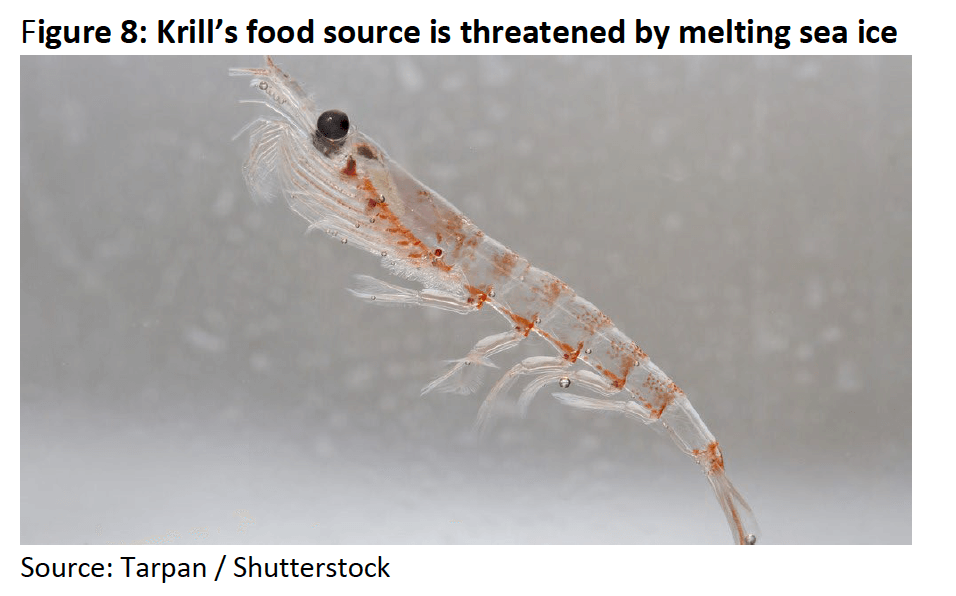
Crustaceans at Risk
Krill, tiny shrimp-like crustaceans (Figure 8), are a keystone species in the Southern Ocean ecosystem. Without this species, Southern Ocean food systems would completely collapse.
The loss of sea ice is reducing the supply of krill that populate the Southern Ocean. Krill are the main food source for whales, seals, penguins, squid and fish. Young krill feed off of algae living in the sea ice. When the ice melts there is no more algae to eat, and the krill die.
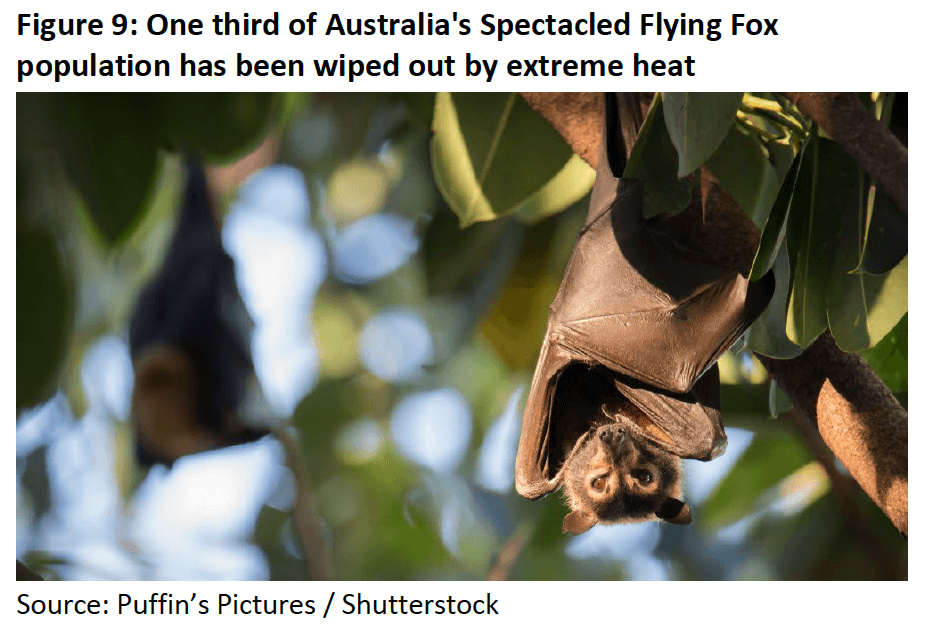
Mammals at Risk
Flying Foxes
The Spectacled Flying Fox (Figure 9) is considered a keystone species in Australia’s tropical rainforests, as it plays a critical role in the dispersal of pollen (pollen sticks to their furry bodies) and seeds (through defecation).
Flying foxes (a type of bat) have been dying in Australia because of extreme heatwaves that the animal is unable to survive. One study7 examined the effects of temperature extremes on flying foxes and the implications for species survival. One-third of Australia’s Spectacled Flying Fox population has been wiped out by extreme heat. It is forecast that the Spectacled Flying Fox will be extinct in 100 years.
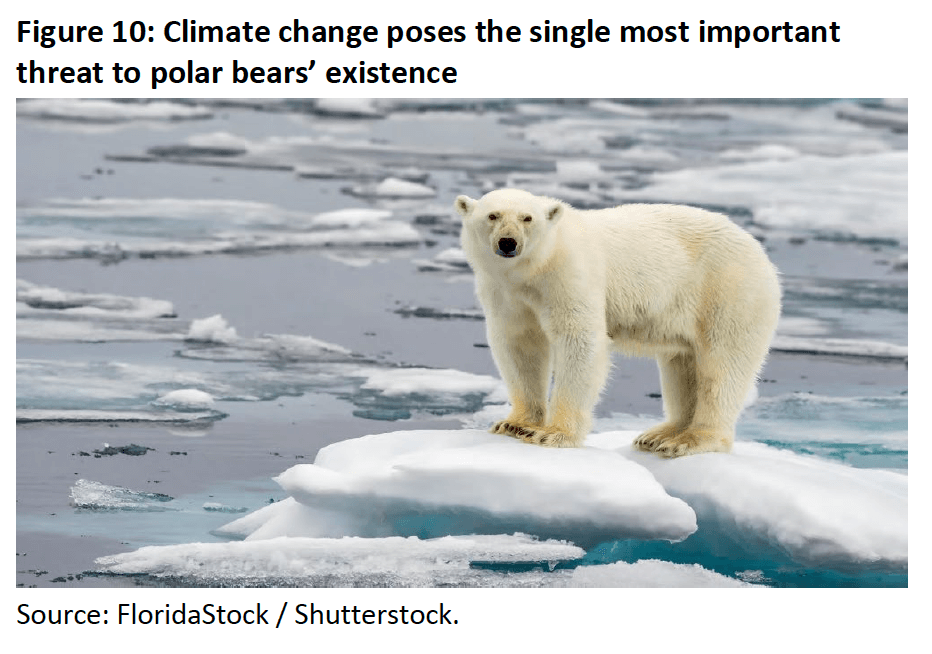
Polar Bears
Polar bears, a keystone species in the Arctic ecosystem, are being directly impacted by climate change in the form of receding sea ice. A research study8 of polar bears found that the animals could be sliding towards extinction faster than previously feared, because of an increasing struggle to find enough food to survive as climate change transforms their environment. Polar bears have high metabolisms, which means they need plenty of prey, primarily seals, to meet their energy demands at a time when receding sea ice is making hunting increasingly difficult.
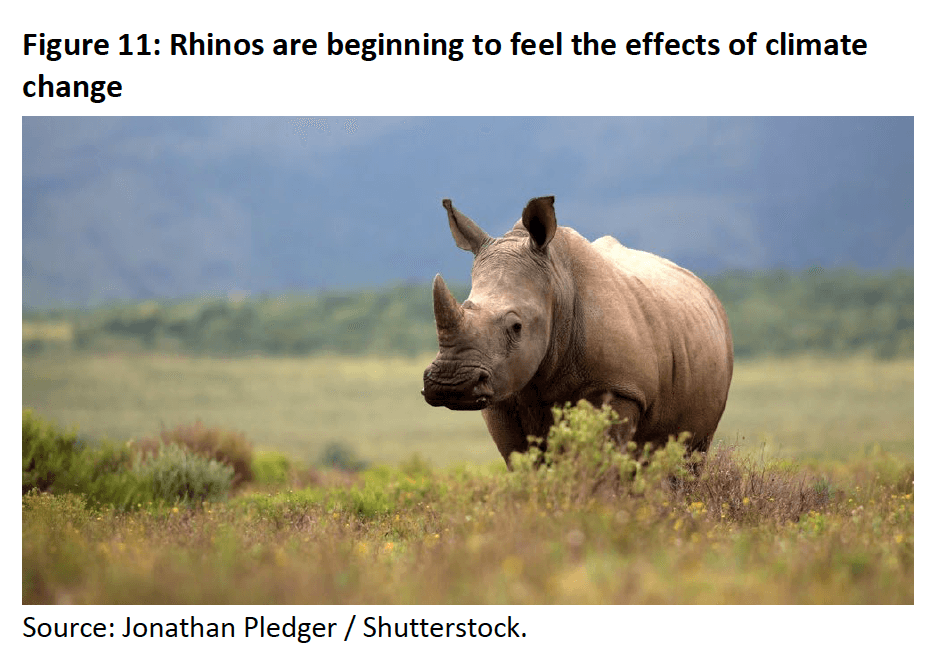
Rhinoceroses
Rhinos are another keystone species. Rhinos increase biodiversity by selectively eating certain kinds of plants over others. By trimming the grasses, the rhinos allow light and water to reach other plants that otherwise might not survive.
Rhinos are beginning to feel the effects of climate change. Significant increases in temperature present a major challenge to rhinos. The animals try to keep cool at the hottest times of day, seeking shade or cool mud. More time keeping cool means less time to browse for food, with the result that animals suffering nutritional stress are less likely to reproduce.
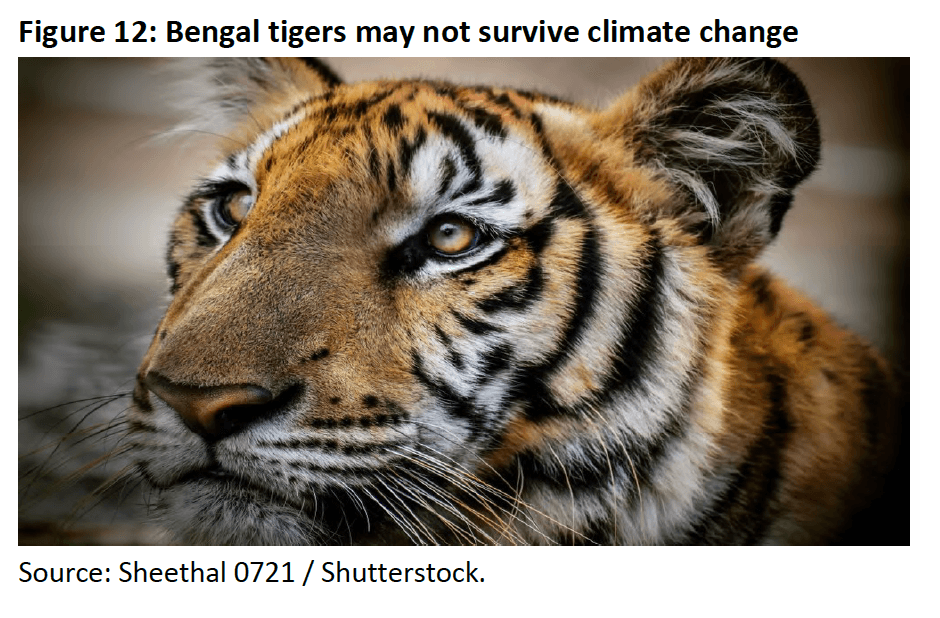
Tigers
Tigers are a keystone species that play a pivotal role in the health and diversity of an ecosystem. They are a top predator that keeps the population of wild ungulates (mammals with hoofs) in check, thereby maintaining the balance between prey herbivores and the vegetation upon which they feed.
The endangered Bengal tiger (Figure 12) is largely concentrated in the Sundarbans, 4,000 square miles of marshy land in Bangladesh and India, which hosts the world’s largest mangrove forest. 70% of the land is just a few feet above sea level. Reflecting the combined effects of climate change and sea-level, a recent study9 concluded that, by 2070, there will be no suitable tiger habitats remaining in the Bangladesh Sundarbans, which could drive the Bengal tiger to extinction.
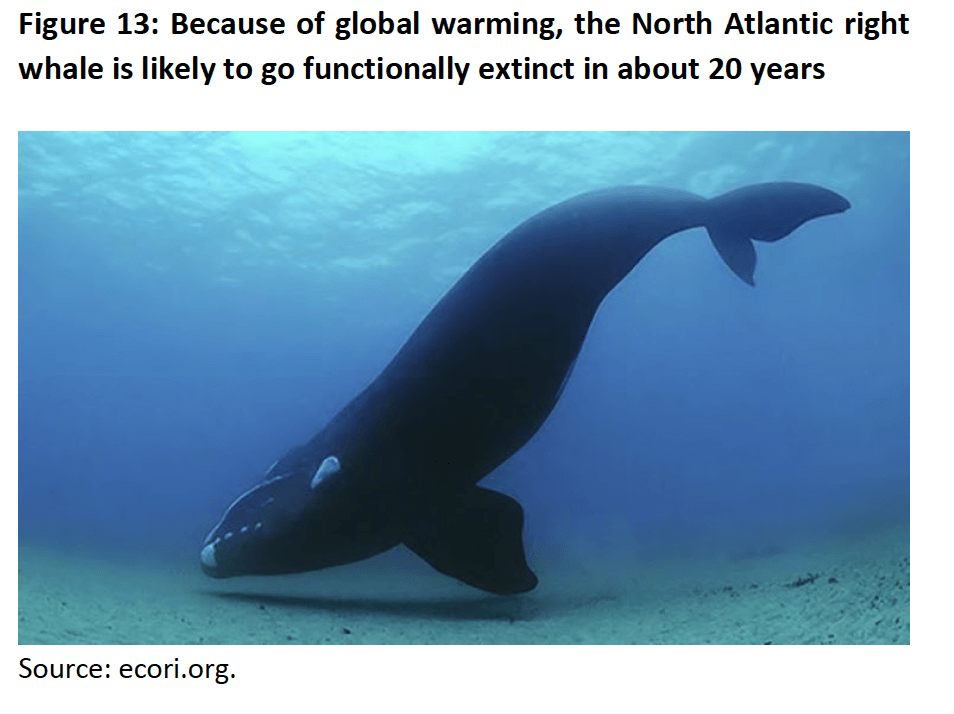
Whales
Whales are keystone species of the oceans — they play a key role in maintaining a healthy ocean ecosystem. Through their defecation, whales fertilize the microscopic phytoplankton (aquatic plants) upon which all sea life depends.
The North Atlantic right whale is one of the most endangered of all large whales — Figure 13. Since warming waters contain less zooplankton (animal plankton, e.g., krill) for whales to feed on, the availability of food due to climate fluctuations is becoming an increasing cause of mortality. Between 300 an 350 individuals still exist, with little hope of population growth. At a congressional hearing in March 2019, a senior science advisor at the New England Aquarium, said “this species is likely to go functionally extinct in about 20 years.”10
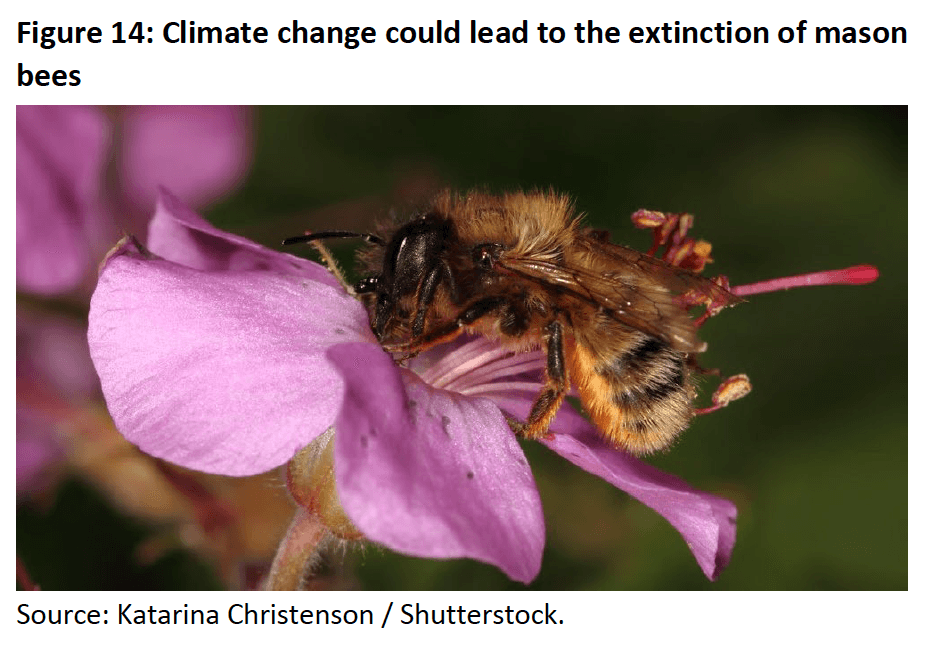
Bees at Risk
Bees are a keystone species, ensuring the continued reproduction and survival not only of plants (through pollination) but other animals that depend on those plants for survival. Albert Einstein acknowledged the importance of bees when he said, “remove the bee from the earth and at the same stroke you remove at least one hundred thousand plants that will not survive.”
Some species of bees have been dying off at a record pace. Bumblebees, honeybees, and wild bee species are all declining. A research study11 found that, if the Earth continues to warm and bees don’t find a way to adapt, climate change could lead to the extinction of these insects. A team of scientists found that 30-70% of mason bees (a primary pollinator in the western U.S. and northern Mexico — Figure 14) died when they heated up the bees’ environments. If temperatures continue to climb, bee populations could begin to die off at faster rates, disrupting ecosystems worldwide. By some estimates, bees worldwide may be extinct by 2119.12
Technologies Helping Save Endangered Species
In the search for solutions to help the plight of endangered species around the globe, some conservationists are turning to various technologies that we outline below.
GPS Technology
“Smart collars” that use GPS technology track not only an animal’s location but also how it is moving, when it is hunting, what it is hunting. Scientists hope that by knowing exactly what certain species of animals are doing, they can understand them much more thoroughly, and possibly even predict behavior.
Remote Control Imagery and Photography
For learning about risks facing endangered species, recording the details of wildlife in their natural habitat can be essential. The challenge is to get up close to an animal, without it detecting a human presence. Thanks to significant advances in remote control imagery and photography, it has become easier to record species in their natural habitat.
Satellite Imagery
Google Earth has become a real tool for the conservation and preservation of species and habitats. Endangered species and their vital habitats are being protected by organizations using this powerful software as a mapping and visualization tool to illustrate the threats to their survival. The World Wildlife Fund developed a virtual tour using Google Earth to help raise awareness of how logging was threatening the Sumatran Tiger’s habit in Sumatra. Save the Elephants is another organization using Google Earth for animal causes. The organization uses the technology to track elephants’ migration patterns, which allows them to know which areas need protection from poachers and other threats.
Gene Therapy / Sequencing
Scientists are using high-tech gene sequencing machines (that examine DNA) in an attempt to save the Tasmanian devil. The animal is threatened by an infectious cancer, called devil facial tumor disease, that is threatening to wipe out the species. The hope is gene therapy can be developed that will provide a cure for the cancer.
For rare and elusive animals, the use of DNA can help determine the presence of a species in less time, with fewer costs and fewer resources than traditional methods. Conservationists can collect DNA profiles from the environment, such as a paw print in the snow or a sample of pond water. DNA and diet information collected from feces of free-ranging animals can also provide insight into the health of the overall ecosystem.
Drone Technology
Drone technology makes it possible to record video and take pictures in the most remote areas of the earth to help monitor conditions for animals in those areas. For example, an ecologist and a biologist have created a conservation drone complete with cameras, sensors and GPS to map deforestation and count orangutans and other endangered species in northern Sumatra. In Kenya, drones equipped with thermal cameras that identify heat, are used by rangers to help find poachers. The advantage of using a drone over other methods to catch poachers is the silent flight of the devices. Elsewhere in Africa drones are being used for elephant and rhino conservation where poaching is a significant problem.
Computer Analysis
A number of big technology companies have developed tools that help conservationists protect species:
- IBM has created predictive analytics software that can be used to collect huge amounts of complex information about wildlife ─ such as where the animals are located, why they are hunted ─ and figures out the best areas to focus conservation efforts.
- Cisco is involved with an initiative aimed at dramatically reducing the number of rhinos being poached in South Africa. Technology was deployed in a private game reserve adjacent to Kruger National Park to monitor and track individuals from the time they enter the reserve gates, until they exit. The goal is to proactively intervene and stop poachers entering the reserve illegally, whether by cutting fences, being dropped onto the ground by helicopters, or simply driving in through the entrance gates.
- Microsoft has developed a machine learning model that is being used to track the Asian snow leopard. Snow leopards have dwindled to an estimated population of 4,000 to 6,000, making them so rare that remote cameras equipped with heat and motion sensors are one of the only feasible ways to study them. However, the cameras face numerous They take photos of the “wrong” animal — such as goats, camels and horses — or are triggered by a blade of grass swaying near a sun-heated rock. A new Microsoft AI solution is accelerating the process of tracking snow leopards, with a machine learning model that can identify snow leopards and automatically classify hundreds of thousands of photos in a matter of minutes.
Investing to Promote Animal Welfare
Some investment management firms understand the need to focus on conservation and animal welfare, which, in turn, will contribute to the preservation of various keystone species. In Figure 15 we describe several investment opportunities aligned with this theme.
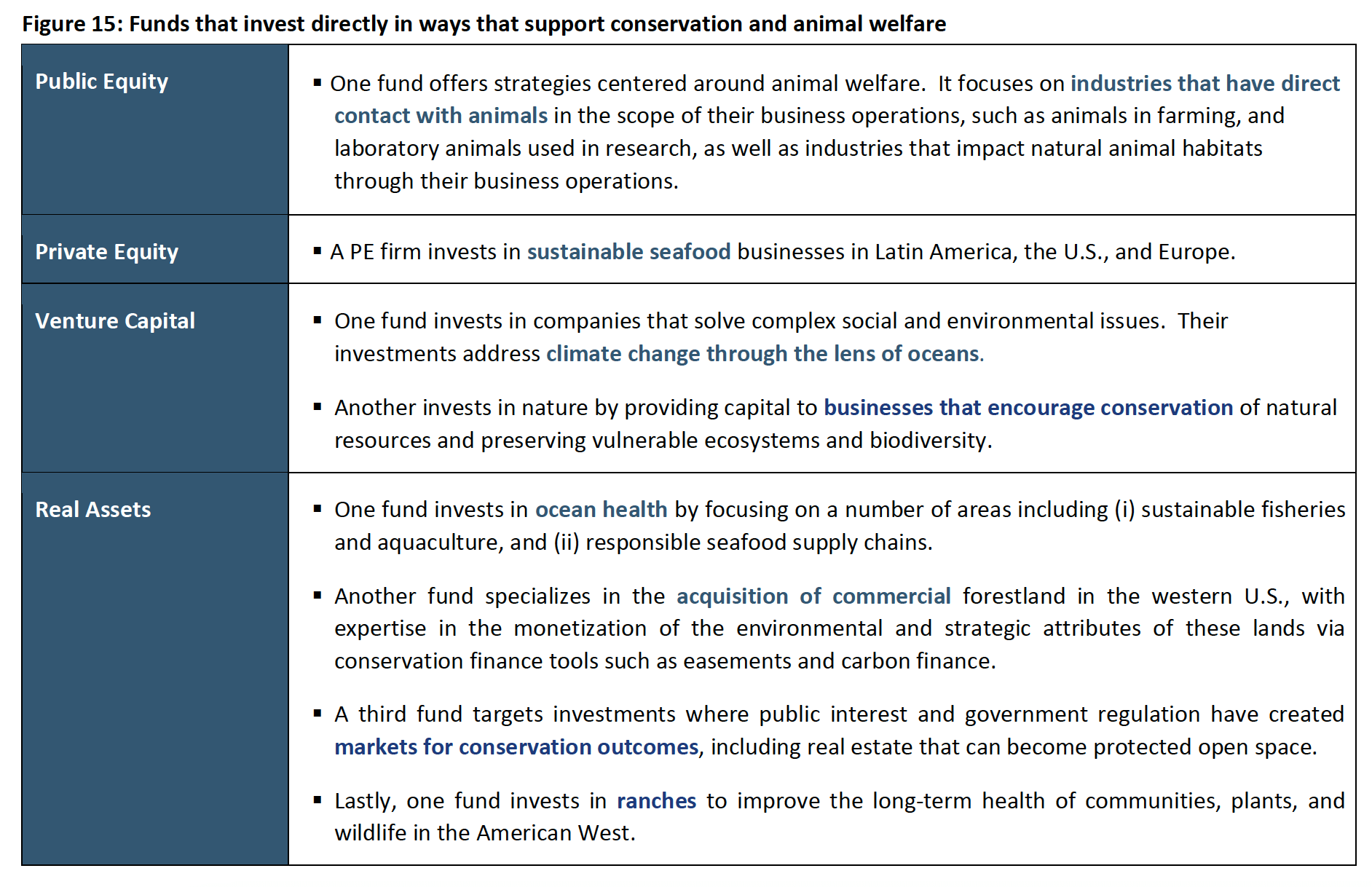
The SDGs and Animal Welfare
It is, of course, also possible (and perhaps necessary for portfolio diversification) to consider animal welfare within the broader context of investing to combat climate change. At Pathstone, we look at this issue through the lens of our Access Impact FrameworkTM, which aligns investment activity to the United Nations Sustainable Development Goals (Figure 16).
Of the 17 SDGs, the two that seem the most relevant to animal welfare are SDG 14 (Life Below Water), and SDG 15 (Life on Land). In addition, there are other SDGs that play a less direct role in animal welfare.
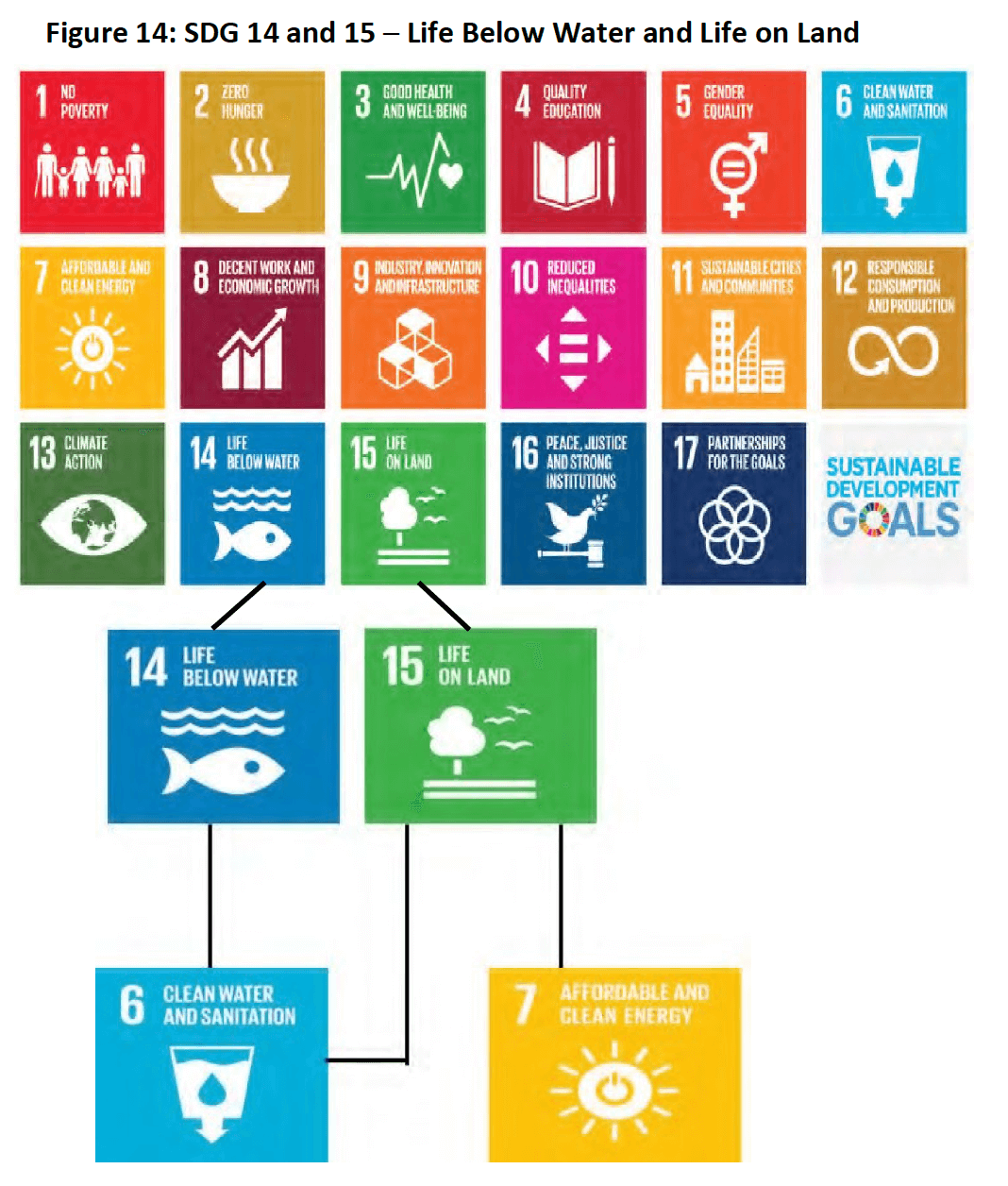
Life Below Water
The global share of marine fish stocks that are within biologically sustainable levels declined from 90% in 1974 to 69% in 2013. Marine protected areas need to be effectively managed and well-resourced, and regulations need to be put in place to reduce overfishing. As of January 2018, just 16% of marine waters under national jurisdiction—that is, 0 to 200 nautical miles from shore— were covered by protected areas.
SDG 14 is also linked with SDG 6 (Clean Water and Sanitation). Our rainwater and drinking water are ultimately provided and regulated by the sea. Approximately 70% of Earth’s surface is covered in ocean water. When water at the ocean’s surface is heated by the sun it gains energy. With enough energy, the molecules of liquid water change into water vapor and move into the air. This vapor rises, cools, and changes into tiny water droplets, which form clouds, the source of rain. Investing in access to clean water through water technologies would benefit animal species as well as humans.
Life on Land
SDG 15 too is linked with SDG 6 (Clean Water and Sanitation). There could be no life on land of any kind without water.
SDG 15 aims to ensure and enhance the health of earth’s terrestrial ecosystems by encouraging sustainable land use and land protection. The past decades have seen a rise in challenges to this goal in the form of global deforestation and the loss of biodiversity. Fortunately, progress can be made through smarter development planning and reducing practices that pollute air and water. Strategies that address SDG 15 also support SDG 7 (Affordable and Clean Energy). Investing in access to clean energy can help reduce air pollution and improve the quality of life for both humans and animals.
If you have any questions or would like to discuss this thematic research report, please contact us.
1 https://www.newyorker.com/magazine/2009/05/25/the-sixth-extinction
2 IUCN 2012. The IUCN red list of threatened species. Version 2012.1
3 https://royalsocietypublishing.org/doi/full/10.1098/rspb.2012.1890
4 Raffel, T.R., J.M. Romansic, N.T. Halstead, T.A. McMahon, M.D. Venesky and J.R. Rohr. 2013. Disease and thermal acclimation in a more variable and unpredictable climate. Nature Climate Change
5 http://onlinelibrary.wiley.com/doi/10.1111/gcb.12111/abstract
6 https://www.ncbi.nlm.nih.gov/pmc/articles/PMC5192889/
7 https://royalsocietypublishing.org/doi/abs/10.1098/rspb.2007.1385
8 “High-energy, high-fat lifestyle challenges an Arctic apex predator, the polar bear,” USGS and UC Santa Cruz, 2018
9 https://www.sciencedirect.com/science/article/pii/S0048969719304310?via%3Dihub#!
10 https://www.ecori.org/narragansett-bay/2019/3/12/right-whale-births-up-this-winter-but-species-faces-extinction
11 http://paulcaradonna.weebly.com/uploads/7/9/6/5/79658256/701826.pdf
12 https://www.sciencedirect.com/science/article/pii/S0006320718313636
Please see the PDF version of this article for important disclosures.

